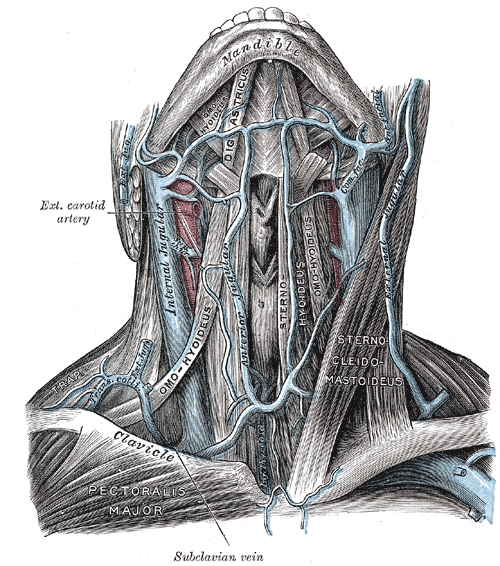Hepatojugular reflux
Editor-In-Chief: C. Michael Gibson, M.S., M.D. [1]
Synonyms and keywords: Abdominojugular test, AJR, HJR
Overview
The abdominojugular test (AJR), also known as hepatojugular reflux or HJR is used as an alternate test for measuring jugular venous pressure (JVP) through the distension or swelling of the jugular vein. A positive AJR best correlates with the pulmonary capillary wedge pressure although it also correlates with the right heart pressure and the left heart ejection fraction [1].
Procedure
The doctor presses firmly over either the Right upper quadrant (liver) or over the center of the abdomen [1] for 10-60 seconds with a pressure of 20 to 35 mm Hg while observing the internal jugular vein in the neck and also observing to be sure the patient does not Valsalva [2].
The internal jugular vein can be distinguished from the carotid artery by
- Having a biphasic waveform
- Falling pressure during inspiration
- Rising with abdominal pressure, and
- Being compressible with direct pressure [2].
When the meniscus of the internal jugular vein cannot be determined, one study found the height of the meniscus in the external jugular vein correlated with the right atrial pressure [3].
- Negative Result: On an otherwise healthy individual, the jugular venous pressure remains constant or temporarily rises for a heartbeat or two, before returning to normal. This negative result would be indicated by a lack of swelling of the jugular vein.
- Positive Result: A positive result is variously defined as either a sustained rise in the JVP of at least 4cm or more [2] or a fall of 4 cm or more [1] after the examiner releases pressure. The AJR has a reported sensitivity of 24% [4] to 72% [1] and a specificity of 96% to 93%. The large discrepancy in sensitivity may be explained by the higher value being reported during performance in optimal conditions of a cardiac lab while the lower value was from a study in an emergency room.
Below is a video demonstrating hepato-jugular reflux {{#ev:youtube|B8OX3T4c7PU}}>
References
- ↑ 1.0 1.1 1.2 1.3 Ewy G (1988). "The abdominojugular test: technique and hemodynamic correlates". Ann Intern Med. 109 (6): 456–60. PMID 3415106.
- ↑ 2.0 2.1 2.2 Cook D, Simel D (1996). "The Rational Clinical Examination. Does this patient have abnormal central venous pressure?". JAMA. 275 (8): 630–4. PMID 8594245.
- ↑ Stoelting R (1973). "Evaluation of external jugular venous pressure as a reflection of right atrial pressure". Anesthesiology. 38 (3): 291–4. PMID 4698149.
- ↑ Marantz P, Kaplan M, Alderman M (1990). "Clinical diagnosis of congestive heart failure in patients with acute dyspnea". Chest. 97 (4): 776–81. PMID 2182296.
